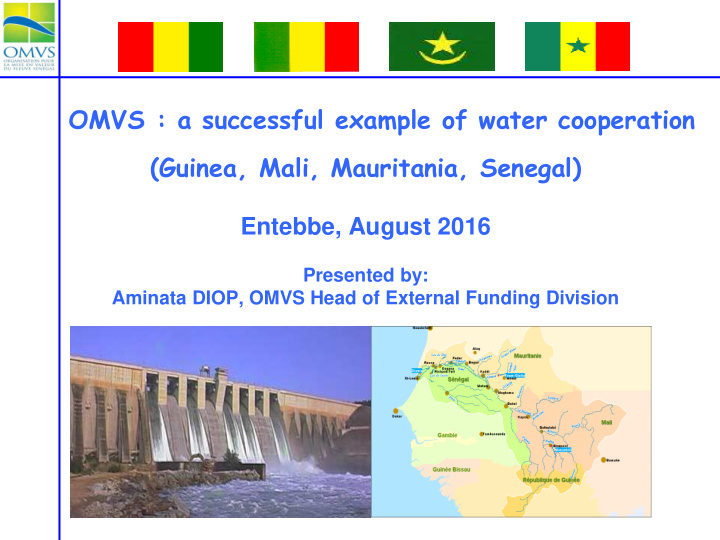



OMVS : a successful example of water cooperation (Guinea, Mali, Mauritania, Senegal) Entebbe, August 2016 Presented by: Aminata DIOP, OMVS Head of External Funding Division
ORIGINALITY OF OMVS EXPERIENCE
OMVS Missions Created on March 11, 1972, the OMVS River Basin Organization is shared by Mali, Mauritania and Senegal, Guinea joined on 17 March 2006 - • Missions : - Improves food security for basin populations; - Reduces OMVS member states economic vulnerability against Climate Changes; - Scales up economic development within the Member- states ; - Preserves the balance of ecosystems within the Basin and in the sub-region; - Secures and improves the Basin Populations incomes
Specific features: Joint management and solidarity spirit • Joint management of the Senegal river basin • Joint management of common infrastructures and assets • Joint investments • Consensus-based decisions: no vote • Inclusive programs that take account of the interests of countries upstream and downstream
Institutional aspect Conference of Heads of States and Government Council of Ministers High Commission Permanent Water Commission Basin Committee of OMVS (CPE) SOGED SOGEM SOGENAV Diama dam Management Agency Manantali Dam Management Agency Navigation Management Agency
Legal framework • 2 conventions signed on 11 March 1972 : one conferring an international status to the Senegal River, and the other establishing the OMVS - • 2 conventions: – One signed on 21 December 1978 on the legal status of jointly-owned infrastructures built on the Senegal River(including dams and navigation structures) and – the other signed on 12 May 1982 on the financing modalities of such jointly- owned infrastructures.
Water Charter of may 2002 : • Sets the Principles and arrangements for water resources allocation to the various use sectors ; • Defines procedures for the examination and approval of new water use projects or projects likely to affect the quality of water ; • Determines rules for environmental protection and preservation ; • Defines the framework and procedures for water users’ participation in decision-making processes relating to the Senegal River resources management International Code of navigation on the Senegal River • Conditions for navigation, safety, piloting, rules for shipping and berthing , casualty assistance and rescue, pollution and penalties. • River transport for people and goods.
Technical Fundaments Permanent Water Commission renewed (CPE) : well-planned and concerted management; Dashboard of Needs versus Resources : technical monitoring of the resources; Master Scheme for the development and management of the Senegal River Waters(SDAGE) : planning of activities; « Costs and Benefits distribution Formula/Key » : technical tool for the management of jointly-owned infrastructures
BENEFITS OF COOPERATIVE MANAGEMENT: PEACEFUL FRAMEWORK FOR JOINT DEVELOPMENT
Agriculture development and food security DIAMA : fresh water for agriculture and safe drinking water Year-round provision of enough fresh water Development of agricultural activities Restoration of natural environment 10
Energy and transport development: Manantali Dam ☻ Storage capacity: 11,3 billions m3 ☻ Energy Production: 800 GWh/year ☻ River flow regulation: 300m3/s at Bakel station ☻ Irrigation capacity: 255 000 ha combined with DIAMA Dam ☻ Artificial flooding(recession agriculture -Environment, … .) ☻ Year – round navigability of the River from Saint- Louis(Senegal) to Ambidédi (Mali); ☻ Control of eventual Flood 11
Manantali :reduce the energy deficit • Producible: 800GWh / year, garanteed 9 years out of 10; • A network of 1 500 km power transmission lines connecting 3 States; • Cheap energy Country Cost (kw) of Cost (Kw) of Manantali thermal power hydropower (in (in FCFA) FCFA) Mali 30 FCFA 165 FCFA Mauritania 31,5 FCFA 90 FCFA Senegal 31,5 FCFA 60 FCFA • Other benefits: River flow regulation irrigation , artificial flooding, year- round navigability of the River 12
13 ESKOM Energy Manantali SEMAF was created recently to replace ESKOM Operation Agreement Tariffs Protocol: 1997; 30 years period Tariffs were increased Power purchase agreement with the National Electricity Companies (SdE) based on hydropower sharing(« costs and benefits distribution key» 52 % MALI (EDM - SA) 15 % MAURITANIE (SOMELEC) 33 % SENEGAL (SENELEC)
OMVS: Existing Dams and Dam Projects
P. BUIRETTE wrote: “At the international level, a prime example of multipurpose planning and integrated development is provided by the Organization for the Development of the Senegal River. But the example of Senegal is unique among the "administrative arrangements known. BUIRETTE P: Genesis of a General International Law of Rivers, RGDIP, 1991, p 5, spec.P.48.
Challenges and benefits of cooperation • Benefits – Exchange of best practices and experience sharing on major issues; – Sharing of resources and means • Challenges – Financial – Technical – Political instability
• More Collaboration will bring more goals to attend; • The spirit of solidarity will be reinforced because things are easier together;
Thank you for your attention For more informations visit www.portail-omvs.org 18
Recommend
More recommend